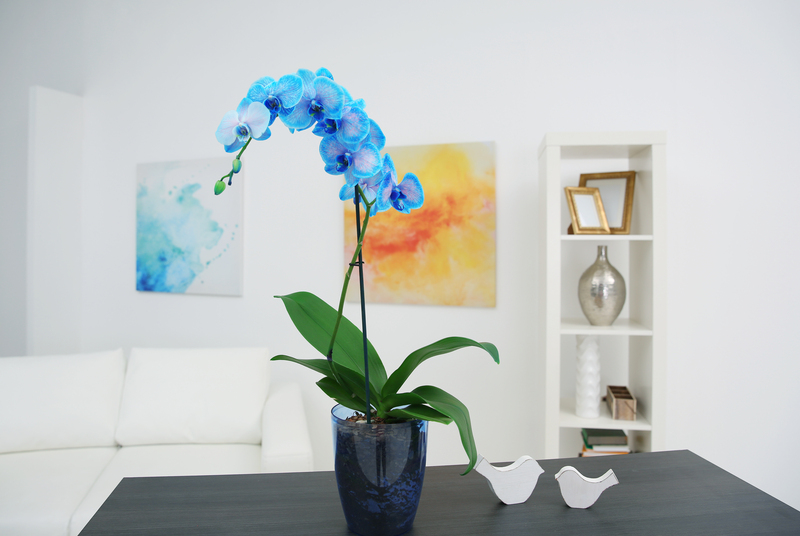Secrets to Maintaining a Verdant Herb Garden
Posted on 02/07/2025
Secrets to Maintaining a Verdant Herb Garden
If you've ever dreamed of stepping outside your door to snip fresh, aromatic herbs for your kitchen, maintaining a lush and healthy herb garden is far easier than you might think. Whether you're a city dweller working with pots on a balcony or a homeowner with ample backyard space, cultivating a verdant herb garden will reward you with unparalleled flavor, fragrance, and visual beauty. This guide unveils comprehensive secrets to keeping your herb garden thriving year-round, with an emphasis on sustainability and practical tips for herb enthusiasts at every level.

Why Grow a Herb Garden?
Besides imparting dishes with vibrant flavors, home-grown herbs offer numerous benefits:
- Freshness and Nutrition: Herbs retain more nutrients and essential oils when harvested fresh.
- Cost Savings: Growing your own can significantly reduce grocery bills.
- Eco-Friendly: Enjoy pesticide-free herbs and reduce packaging waste.
- Aesthetic Appeal: Lush greenery enhances your garden's charm.
- Well-being: The act of gardening lowers stress and elevates mental health.
Choosing the Right Herbs for a Lush Herb Garden
Annual vs. Perennial Herbs
- Annuals: These herbs, such as basil, cilantro, and dill, live for a single season but often yield prolifically.
- Perennials: Examples include rosemary, thyme, sage, and mint. Plant them once and enjoy for several years.
Tip: Mix both types to ensure continuous, lush growth throughout the year.
Herb Selection for Your Location
- Sun exposure: Mediterranean herbs like lavender, rosemary, and oregano thrive in full sun, while parsley and mint can tolerate partial shade.
- Soil Type: Most herbs prefer well-draining soil. Raised beds or containers are excellent for controlling soil quality.
- Climate Adaptability: Choose varieties suited to your region. Consult local nurseries for native or adaptive options.
Creating an Ideal Setting for a Flourishing Herb Garden
Soil Preparation: The Foundation of Verdancy
Healthy soil is the secret to luxuriant herb growth. Prioritize these steps:
- Soil Testing: Assess soil pH and fertility. Most herbs prefer slightly alkaline to neutral pH (6.0 - 7.5).
- Aeration: Loosen compacted soil to promote healthy root development.
- Enrichment: Mix in compost or organic matter to boost nutrients and enhance water retention.
Pro Tip: Avoid heavy, clay-rich soils that can suffocate roots and cause rot. Opt for a soil blend tailored to herbs, available at most garden centers.
Sunlight: Powering Verdant Growth
- Most herbs thrive in at least 6-8 hours of direct sunlight daily.
- If growing indoors, position pots near south-facing windows or use LED grow lights as a supplement.
- Rotate pots weekly to ensure uniform exposure and prevent leggy growth.
Remember: Too little sun leads to spindly, weak plants; too much, especially in hot climates, can scorch leaves--offer afternoon shade when necessary.
Irrigation Secrets for a Lush, Green Herb Garden
How Much Water Do Herbs Really Need?
Overwatering is the #1 mistake gardeners make--herbs dislike soggy roots. Instead, follow these irrigation techniques:
- Let the top inch of soil dry before watering.
- Water deeply but less frequently to encourage roots to grow downward.
- Morning watering is best--it reduces evaporation and fungal risks.
- Use mulch to trap moisture in the soil, especially in hot climates.
Expert's Secret: Herb planters with drainage holes prevent waterlogging. Check for standing water after heavy rains.
Fertilizing for Vigorous, Verdant Herbs
Understanding Herb Nutrient Needs
- Light Feeders: Most herbs are not heavy feeders and can bolt or lose flavor if overfertilized.
- Compost: Work rich compost into the soil twice a year--spring and midsummer.
- Organic Alternatives: Seaweed extract, fish emulsion, or worm castings provide slow, steady nutrition.
Avoid synthetic fertilizers that cause rapid, leggy growth and diminish essential oils responsible for herb flavor.
Pruning and Harvesting: The Secret to Bushy, Abundant Herbs
How and When to Cut Your Herbs
- Start harvesting when plants reach about 6-8 inches tall.
- Always use clean scissors for a clean cut, just above a leaf node.
- Pinch or trim regularly (every 1-2 weeks) to prevent flowering and promote bushiness.
- Never remove more than a third of the plant at one time to avoid stress.
Secret to Fresh Flavors: Morning is best for harvesting, when essential oils are most concentrated and flavors are at their peak.
Protecting Your Herb Garden from Pests and Diseases
Natural Solutions to Common Problems
- Aphids: Control with a strong blast of water or introduce ladybugs.
- Slugs & Snails: Hand-pick or use crushed eggshells as a barrier.
- Fungal Issues: Water at the base, avoid wetting foliage, and ensure good air circulation.
- Companion Planting: Grow marigolds, chives, or nasturtiums nearby to repel unwanted insects.
Proactive Maintenance is Key: Check plants regularly for early signs of trouble. Remove infected leaves promptly to prevent spread.
Overwintering and Seasonal Care for a Year-Round Verdant Herb Garden
Surviving the Chill
- For tender perennials like rosemary or basil, pot them up and bring indoors before frost.
- Mulch outdoor herbs with straw or leaf litter to insulate roots.
- Cut back woody herbs (like thyme) lightly before winter but avoid heavy pruning.
Insider Tip: Grow herbs like chives, parsley, and mint in containers so you can move them easily as seasons change.
Unique Secrets for a Stunning, Diverse Herb Garden
Design for Beauty and Utility
- Mix textures and heights: Pair feathery dill with mounding thyme, and upright basil with spreading oregano.
- Interplant herbs with flowers: Lavender and calendula add color and attract beneficial insects.
- Feature sensory herbs: Lemon balm, scented geranium, and mint appeal to both sight and scent.
Rotate and Refresh Your Plantings
- Rotate annual herbs each season to prevent soil-borne diseases.
- Rejuvenate beds with fresh compost and organic amendments in early spring.
- Replace failing plants promptly with new, vigorous starts.
Secrets to Growing Herbs Indoors for Year-Round Verdancy
Even if outdoor space is limited or weather turns cold, you can nurture a thriving indoor herb garden:
- Choose compact varieties suited for containers (e.g., bush basil, chervil, dwarf oregano).
- Ensure plenty of light: Use grow lights if natural sunlight is insufficient.
- Maintain consistent temperatures and avoid cold drafts.
- Group plants together to maximize humidity and minimize stress.
Rotate pots weekly to promote uniform growth and pinch regularly for a bushy shape.
Sustainable Secrets for Eco-Friendly Herb Gardening
- Collect rainwater for irrigation to conserve resources.
- Compost kitchen scraps to recycle nutrients back into your garden.
- Reuse containers and avoid plastics by choosing terra cotta, ceramic, or recycled materials.
- Attract pollinators and beneficial insects by planting native flowers among your herbs.
Frequently Asked Questions: Growing a Verdant Herb Garden
- How can I keep my garden green during extreme heat?
Mulch heavily, water in the early morning, and offer temporary shade during peak sun. - Which herbs best tolerate neglect?
Oregano, thyme, rosemary, and sage are remarkably drought-tolerant once established. - Can I grow a lush herb collection in small spaces?
Absolutely! Use vertical planters, hanging baskets, and window boxes for maximum capacity. - How do I boost essential oil content in my herbs?
Limit fertilizer, provide full sun, and harvest just before flowering for the most potent flavors.

Conclusion: Unlocking the Secret to a Verdant Herb Garden
With patience, care, and the right approach, anyone can enjoy the bounty of a lush, green herb garden year-round. The secrets are simple--provide healthy soil, ample sunlight, proper irrigation, regular harvesting, and proactive maintenance for pests and diseases. Embrace both time-tested methods and modern innovations, and your herb patch will reward you with fragrance, flavor, and beauty season after season. Start small, nurture often, and savor the freshness only a well-tended, verdant herb garden can bring.
Take Action: Start Your Journey Toward a Verdant Herb Haven Today!
Ready to transform your outdoor (or indoor!) space into an aromatic paradise? Select a few herbs, prepare nutrient-rich soil, ensure plenty of sunlight, and enjoy the process. The secrets to maintaining a verdant herb garden are well within your reach. Happy gardening!





